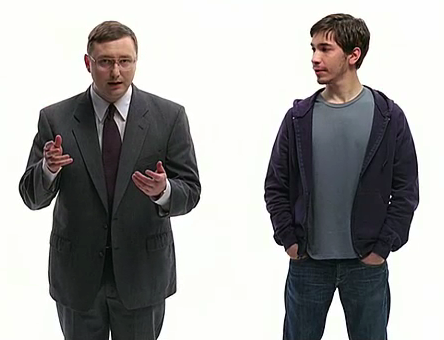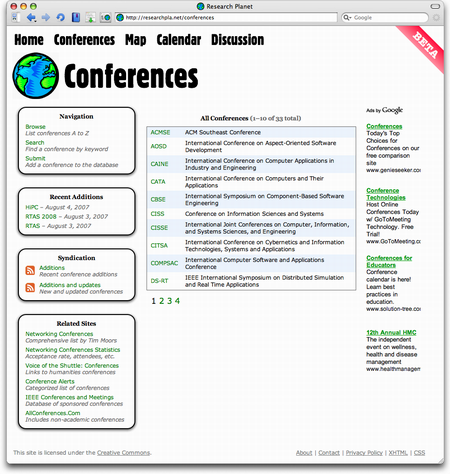Entries Tagged 'Research' ↓
June 10th, 2009 — Personal, Research, Trivia
Inspired by Morgan Deters’ Dissertation Countdown, I thought it would be fun to find out how my own dissertation grew over time. Although I never had the foresight to run a nightly script like Morgan’s, I did record all of my changes in a Subversion repository. It’s like having a virtual time machine that can backtrack through the complete history of my work. With a tool such as StatSVN, I can create a nifty graph that shows my research activity over the last couple of years. This one shows the increase in dissertation size over time:
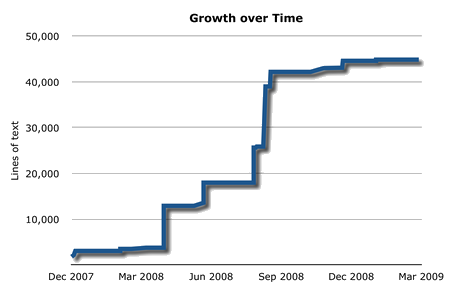
It’s a bit misleading because my dissertation work actually started well before December 2007. I’d been writing code and publishing some initial results in early 2006, but I didn’t start merging it all into a single coherent document until late 2007. Much of the effort from then on was largely a matter of polishing code and evolving the overall narrative, which explains the remarkable growth in the summer of 2008. (It makes me look uncharacteristically productive.) My effort subsided as my defense date drew near, finally ending in March 2009 when I graduated.
StatSVN can also reveal a finer grain of activity. This one shows the number of commits by day of the week:
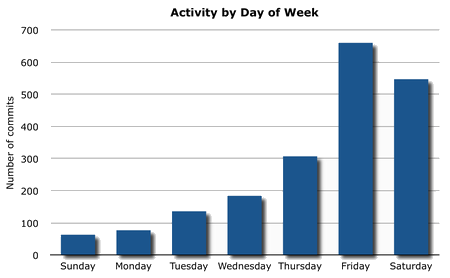
There’s a distinct pattern here. My productivity seems to increase closer to the weekend, peaking mysteriously on Friday. One explanation is that I started working full-time before my dissertation was complete. Another explanation is that this is a sad testament to my social life. I prefer to think it’s the former.
Zooming in even closer on my daily activities, StatSVN can show Subversion commits by hour of day:
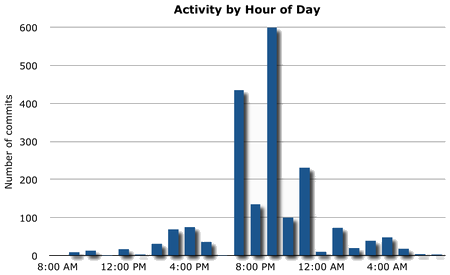
I suppose the insight here is that I become super-productive late in the evening, but I’m pretty much dead in the morning hours. If you need me to do something, don’t expect it done before lunchtime.
While these charts show progress over time, I was also curious about what exactly I ended up with. Here are some quick stats I collected about the dissertation itself:
| Pages |
308 |
| Citations |
286 |
| Sentences |
1468 |
| Words |
26757 |
| Average words per sentence |
18.23 |
| Percentage of words with three or more syllables |
23.31% |
| Average syllables per word |
1.79 |
| Gunning fog index |
16.61 |
| Flesch reading ease |
36.76 |
| Flesch-Kincaid grade |
12.00 |
The readability statistics were collected by Juicy Studio’s Readability Test. The fogginess is at 16—pretty high but still in the expected range for an academic paper. The reading ease of 36 (on a 100-point scale) is also depressingly low, considering how much time I spent rewriting my words to make them flow and digest well. The grade level indicates that a person would need at least twelve years of schooling to understand the paper, which sounds about right.
Finally, here’s a tag cloud derived from the text of the dissertation. The bigger the word, the more frequently it occurs in the text.
algorithm analysis bytecode cache canteen cascade case code collection compiler control data design element example execution figure flow graph hard include instruction interactive java known language library loop memory method performance pool problem processor program real-time requires result safety-critical software source static structure systems techniques timing tools tree wcet worst-case
May 23rd, 2008 — Personal, Research
After spending most of my life in school—I’m now in the 21st grade—and working for the last half-decade on a Ph.D., my career as a student is nearly at an end. It’s time to find a new one.
For a while, I seriously considered life as a professor, but as a graduate student I saw how the sausage was made, so to speak. It’s not all teaching and research. Professors spend a large portion of their time searching for funding, performing administrative tasks, and struggling with departmental politics. For some, these chores are a small price to pay for the chance to live on the cutting edge of science, train talented students, and possibly become famous in their chosen field. For me, however, having to write grant proposals and surrendering to the publish or perish system takes the fun out of academia.
Instead, I decided on an industry job. It wouldn’t offer as much flexibility and independence as being a professor, but it pays a little more and the hours are more predictable. (I’d never have to kill a weekend grading papers, for instance.) Plus, industry offers something academia can’t: instant gratification. With academic research, I may have to wait ten or even twenty years to see whether my ideas lead to a genuine scientific advancement or just another chapter in the annals of obsolete academic research. I can’t be sure that my hard work will ever have an impact on people’s everyday lives.
An industry job, on the other hand, offers immediate impact. Think about the engineers who built, say, Gmail or the iPhone. These products aren’t exactly technological breakthroughs, but their creators have the satisfaction of knowing that their work benefits millions of people every single day.
I had that feeling once, many years ago, when I worked for a tiny startup company in St. Louis. We were building a handheld medical device for early diagnosis of hearing problems in newborns. It was a remarkable feeling to know that my work would soon end up in the hands of pediatricians all over the country.
In January, I started on a journey to get that feeling back. First, I updated my résumé and uploaded it to a few of the mainstream job sites like CareerBuilder and Monster. Soon my inbox was full of email from staffing agencies, but most of the offers were for web development, user interface design, and application programming, nothing particularly exciting.
Next, I contacted a few companies directly. I’ve always admired products from Google, Apple, and Sun, and just as importantly, they have a company culture that appeals to me. All three are very open-source friendly, for example. I sent them a copy of my résumé and was lucky enough to get a call back from each of them for a job interview.
My luck ended there. After the interviews, Apple said that my “interests and skill set lie elsewhere”; Sun told me that “your work and our needs don’t really match”; and Google somehow decided on the basis of a phone interview that my computer programming skills weren’t on par with their standards.
Eventually, I secured offers from a few other companies, but I wasn’t really fired up about any of them. By now it was April and I was running out of time. Not only was my fellowship funding set to expire, but I was nearly finished with my Ph.D. anyway. I needed to make a decision soon, so I pulled out my job hunting notes for one last look. Maybe I had missed something.
Mixed in with my list of prospective companies was a curious entry that sounded like something out of an Isaac Asimov novel: Perrone Robotics. I wondered why I hadn’t contacted them before. I knew I had planned to, but somehow I never got around to it. I sent them my résumé.
The next day, Paul Perrone called me, and we spoke for an hour about his company, my background, and where the two intersect. Soon afterward, he invited me to Charlottesville, Virginia, where Perrone Robotics is based, to meet the team and learn more about the projects they were working on. One week later, Paul offered me a job, and I accepted.
Even if Google, Apple, and Sun had all offered me a position as well, I probably still would have chosen Perrone Robotics. Getting paid to build bots and autonomous vehicles is more or less my dream job. The opportunity for this kind of career is exactly what brought me back to school as a graduate student in the first place. The work is also a good match for my skills because the company’s technology is built entirely around real-time Java, which happens to be the focus of my Ph.D. dissertation.
I’m not the only one excited about Perrone Robotics. Paul’s choice of technology has recently caught the eye of Sun, the company that created Java. For each of the last three years, Sun executives have invited Perrone and his team to present their work at JavaOne, the annual developer conference for all things Java. The executives probably believe, quite rightly, that remote-controlled helicopters and driverless cars are a more exciting demonstration of Sun’s technology than the usual fare of web services, mobile phones, and enterprise frameworks that have traditionally been Java’s purview.
You can judge for yourself by watching the videos below, where Paul gives the JavaOne audience a taste of real-time robotics. (The MC in these videos is none other than James Gosling, best known as the father of the Java programming language.)
Perrone Robotics — JavaOne 2006
Perrone Robotics — JavaOne 2007
Perrone Robotics — JavaOne 2008
The next step for me is to pack up my belongings and get ready to leave Irvine, California, which has been my home for the last five years. The trip will take me to the opposite side of the country, more than 4000 kilometers away, to a new home and, I hope, the start of a satisfying new career.
January 8th, 2008 — Research, Tips
Like most universities, UCI has a strict set of rules for formatting and typesetting doctoral dissertations. The rules fall into the usual categories of margin, typeface, and layout guidelines, as well as some unique requirements for copyright declarations, the signature page, a curriculum vitae, and so on. A complete list is provided in the UCI Thesis and Dissertation Manual.
With so many requirements in this 43-page manual, starting out on the first draft of a dissertation can be rather daunting for Ph.D. students, especially since improper formatting could get the manuscript rejected by the University Archives. A word processor template would virtually eliminate this problem, but according to the AGS website, UCI provides no officially-sanctioned template for dissertations. Each student must format their manuscript from scratch, leading to duplicated effort and wasted time.
A few enterprising students have responded to this problem by creating unofficial UCI dissertation templates. They are designed specifically for LaTeX, a document preparation system favored by EECS and ICS grad students for its extensive support for mathematical equations, high-quality typesetting, and similarity to a computer programming language. By starting off with such a template as the foundation, writing a UCI dissertation essentially becomes a fill-in-the-blank process as LaTeX takes care of the table of contents, list of figures, and other formatting details automatically.
Xianping Ge created the first such template in 2002. It was later refined by Jeffery von Ronne and is now available on Vivek Haldar’s blog. Working separately, I started with Xianping’s original template and made my own set of clean-ups and enhancements with help from Mark Panahi. It improves upon Jeffrey’s version by adding a CV template, extensive comments to help the Ph.D. student fill-in and customize the template, and various minor fixes. In addition, I reviewed every aspect of the template to make sure that its output conforms to the Dissertation Manual as closely as possible.
The template can be downloaded by following the link below, which leads to a ZIP file containing the template, its LaTeX class file, a makefile for generating a PDF of the dissertation, a sample bibliography, and a “readme” file with more details on how to use the template. The link will be updated as new versions of the template become available.
LaTeX template for UCI dissertations
Last updated: March 23, 2009
August 17th, 2007 — Research
As a new graduate student, one of the first things I learned was that the success of a researcher depends on the publish-or-perish model. It’s not a perfect system, but the pressure to generate publications of truly novel ideas does tend to motivate cutting-edge research. The peer-review process also provides valuable objective feedback for researchers, and it usually prevents low-quality work from being published. As a result, publication frequency has become—for better or for worse—the primary method of judging a researcher’s status and ability.
With the advent of the Internet, finding these publications has become a much simpler task. Spiders such as CiteSeer and Google Scholar, as well as publisher databases from IEEE and Springer, can find relevant publications with a simple keyword search. Some sites even offer vital statistics, such as the number of times a paper has been cited, to help judge the importance of the work. These tools are an enormous help when researching a topic.
But what happens when the research is done and it’s time to publish your own work? Surprisingly, finding a relevant conference or journal is often more difficult than finding a relevant publication. Searching the web can help, but you might overlook new or esoteric venues. For a more comprehensive search, professional organizations provide complete lists of the conferences they sponsor, but these too are limited. For instance, the ACM conference database doesn’t list IEEE events, while the IEEE database doesn’t list ACM events. And neither web site has any knowledge about conferences outside of their respective fields.
Making matters worse, some conferences have been accused of being “fake,” lacking any form of peer review and accepting all submissions (even randomly-generated papers) simply to make a profit. Journals, too, have been known to spam researchers with offers to publish in exchange for a fee. Given the key role that conferences and journals play in the integrity of research, these trends are disturbing.
After several years of dealing with these issues, always feeling a bit in the dark when it came to keeping track of research venues, I finally decided to do something about it: I created Research Planet, an independent, cross-discipline source of information about conferences and journals. Designed to make the life of a researcher easier, it offers:
- A searchable database of venues with filtering by acceptance rate, submission deadline, and other criteria
- A global, interactive map to help you locate upcoming conferences in your region of the world
- A calendar of events (available for importing into Apple iCal, Google Calendar, and other calendaring applications) so that you’ll never miss another submission deadline
- A forum for discussing conferences and journals
- Customizable web feeds to keep you informed of new venues and other updates to the Research Planet database
Over time, I’ll be adding additional features, such as user comments, a rating system, photo handling, and more. I also plan to import conference data from other organizations, making the Research Planet database more comprehensive. Together, these features will help you find the best place to publish your work.
December 13th, 2006 — Rants, Research
Sawsan Salameh has been dreaming of getting a doctorate since the age of sixteen. Now 29, her dream has been placed on hold because none of the universities in her native Palestine offers a Ph.D. program in theoretical chemistry, her chosen subject. Studying abroad wasn’t an option, for she comes from a traditional Muslim family and believes traveling abroad alone is improper. Making matters worse, her father recently passed away, leaving Sawsan to provide for her mother and younger sister.
Suddenly, luck changed for Sawsan. She applied to Hebrew University in East Jerusalem, just a short drive from her home in the West Bank, and not only did she gain acceptance, she received a full scholarship. She hopes to use her future degree to launch a career as a chemistry professor.
Only one obstacle remains: the Israeli checkpoint at the East Jerusalem border. Protected by barbed wire and machine guns, it blocks Sawsan from even setting foot on the university’s campus. Obtaining a permit for entry is possible—fourteen Palestinian students are currently enrolled in Israeli universities—but Sawsan’s application was denied eight times. (The government of Israel has become much tighter with permits since the Hamas takeover of Palestine in March.)
With help from the human rights group Gisha, Sawsan appealed to Israel’s High Court of Justice. After a month of delays and hearings, Sawsan’s dream was finally about to come true! The court overruled the government and approved a permit that would allow her to attend school in Israel…for six months.
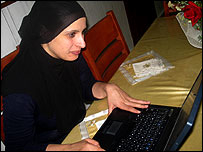
Sawsan Salameh
Photograph © BBC News
The idea that anyone could complete a doctoral degree in six months is ludicrous. To put this in perspective, consider that in the United States, earning a Ph.D. in the sciences requires about seven years of post-Bachelor’s study. Sawsan’s six-month permit, which the High Court apparently considers a gift, is as good as none.
The Israeli authorities haven’t commented publicly on this case, so one can only imagine what they were thinking.
October 16th, 2006 — Personal, Research
Last summer, I sent a quick e-mail to the editors at SERVO Magazine thanking them for their online service. Free to all subscribers, the service provides electronic copies of back issues, which is great for when I see an article that’s relevant to my research and I want to archive it.
Other publishers provide electronics copies, too, but you usually get a weak HTML conversion, or you have to pay extra to get the full back issue database, or both. SERVO, on the other hand, offers high-res, fully searchable PDFs of every issue, and they match the printed version exactly. Not many publishers go that extra mile.
When the October issue of SERVO arrived, I found a reprint of my little email on page 7.
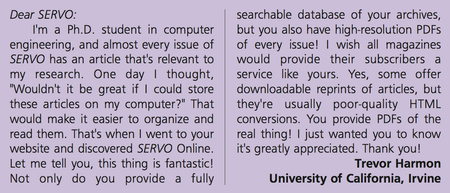
October 4th, 2006 — Gadgets, Personal, Research
Nate Anderson wrote an excellent article for Ars Technica about the recently released version 2 of the Robosapien. This humanoid robot is just a toy, but it’s supposedly one of the most advanced toys ever. After all, the manufacturer claims that the Robosapien V2 is a “highly evolved robotic fusion of technology and personality, combining fluid biomechanical motion with a multi-sensory, interactive humanoid personality.â€
That’s quite a statement! But how does it compare with reality? The answer can be found in one of Nate’s videos. Here, Robosapien demonstrates a new ability: bowling.
ROBOSAPIEN BOWLING
(turn your sound up)
Copyright © Ars Technica
[flashvideo file=http://vocaro.com/trevor/blog/wp-content/uploads/2009/06/robosapien_bowling.mp4 width=450 height=338 /]
Wow-wee! (Sarcasm.)
Yes, I realize Robosapien is just a toy, but I think the video perfectly illustrates the state of robotics today. There’s an enormous disconnect between the kind of robot we want to build:

…and the kind that’s actually available to us:
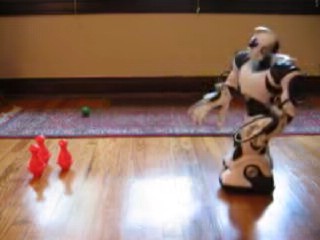
In other words, the field of robotics is wide open. There’s so much work to do, so much more we’ve yet to accomplish! In fact, the robotics industry looks so compelling and full of promise that I’m seriously considering making a career of it. I’m convinced this century will come to be known as The Robotics Age, and I want to be ready for it! In fact, I’m already finding myself focusing on robotics as the major “motivating example†for my doctoral thesis.
Who knows? Maybe one day I’ll learn enough to create a robot that can actually bowl…
September 12th, 2006 — Humor, Research, Trivia
One of the things you learn as a Ph.D. student is how to do research. Though I’m still far from mastering that particular lesson, there’s something I’ve discovered along the way: Academic researchers love coming up with long titles for their papers. In fact, a colleague’s recent 27-word Ph.D. thesis had me wondering, “Just how long do these titles get?†I decided to find out. I wrote a little script that scans the DBLP database and spits out the longest titles it finds (based on number of characters, not words). Excluding non-English titles, here’s the top-ten list:
- In silico exploration of the fructose-6-phosphate phosphorylation step in glycolysis: genomic evidence of the coexistence of an atypical ATP-dependent along with a PPi-dependent phosphofructokinase in Propionibacterium freudenreichii subsp. shermanii
- A Comparative Study of Artificial Neural Networks Using Reinforcement Learning and Multidimensional Bayesian Classification Using Parzen Density Estimation for Identification of GC-EIMS Spectra of Partially Methylated Alditol Acetates on the World Wide Web
- Performance of empirical potentials (AMBER, CFF95, CVFF, CHARMM, OPLS, POLTEV), semiempirical quantum chemical methods (AM1, MNDO/M, PM3), and ab initio Hartree-Fock method for interaction of DNA bases: Comparison with nonempirical beyond Hartree-Fock results
- Joint quantum chemical and polarizable molecular mechanics investigation of formate complexes with penta- and hexahydrated Zn2+: Comparison between energetics of model bidentate, monodentate, and through-water Zn2+ binding modes and evaluation of nonadditivity effects
- A Simple Flexible Program for the Computational Analysis of Amyl Acyl Residue Distribution in Proteins: Application to the Distribution of Aromatic versus Aliphatic Hydrophobic Amino Acids in Transmembrane alpha-Helical Spanners of Integral Membrane Transport Proteins
- Three-Dimensional Quantitative Structure-Property Relationship (3D-QSPR) Models for Prediction of Thermodynamic Properties of Polychlorinated Biphenyls (PCBs): Enthalpies of Fusion and Their Application to Estimates of Enthalpies of Sublimation and Aqueous Solubilities
- WEB OBJECTS TIME: When Microsoft Started Speaking Like a Good Open-Standards Citizen, The Netscape Extensions Tail Tried to Wag The Dog and Object-Oriented Software Turned Static Web Pages Into Dynamically-Linked Access Boulevards to Significant Online Collection Databases
- Hydrogen bonding in diols and binary diol-water systems investigated using DFT methods. II. Calculated infrared OH-stretch frequencies, force constants, and NMR chemical shifts correlate with hydrogen bond geometry and electron density topology. A reevaluation of geometrical criteria for hydrogen bonding
- Molecular mechanical models for organic and biological systems going beyond the atom centered two body additive approximation: aqueous solution free energies of methanol and N-methyl acetamide, nucleic acid base, and amide hydrogen bonding and chloroform/water partition coefficients of the nucleic acid bases
- The nucleotide sequence of a 3.2 kb segment of mitochondrial maxicircle DNA from Crithidia fasciculata containing the gene for cytochrome oxidase subunit III, the N-terminal part of the apocytochrome b gene and a possible frameshift gene; further evidence for the use of unusual initiator triplets in trypanosome mitochondria
Of course, a trivia researcher’s work is never done. For future analysis, I’ll focus on papers with the highest number of authors. (I’ve already discovered a potential candidate.)
August 30th, 2006 — Research, Trivia, TV
After reading a recent Slashdot article about a Star Trek Ph.D. thesis winning an academic prize, I wondered how many other theses involve Star Trek. According to Digital Dissertations, the answer is no less than fourteen! Here’s the list so far, from oldest to most recent:
And this list includes only Ph.D. dissertations in English that have the phrase “Star Trek†in the title. I’m sure there are many more theses that involve Star Trek in some peripheral way, not to mention journal articles, conference papers, and non-English publications.
As a Star Trek fan, I’m rather pleased that my favorite sci-fi franchise is considered worthy of serious academic study.
August 17th, 2006 — Mac, Rants, Research, Software
My colleagues and I were finally able to publish our Autonet research at a conference in Chicago. Being the lead author, I hopped on a flight to the Windy City last Tuesday to present the results of our work. When I arrived at the hotel, I met the other two speakers scheduled for the afternoon session. The first one was busy setting up his Dell at the podium while the audience slowly began to fill the room. The second speaker had no laptop, only a USB drive with his slides; he was hoping to borrow the first speaker’s Dell.
We were about two minutes away from showtime when the projection screen suddenly froze. Here’s what everyone in the audience saw:
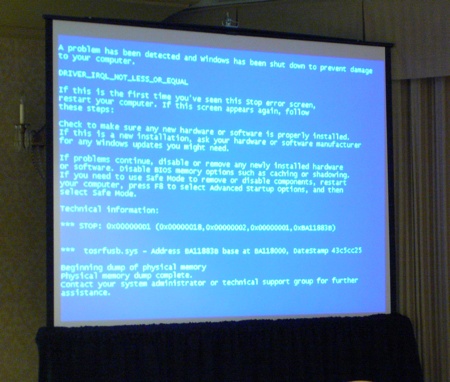
It turned out that the guy’s Dell was crashing whenever he tried to start his PowerPoint presentation. Rebooting didn’t help. Windows insisted on giving him the Blue Screen of Death.
By this time, we were now late. Frustrated, the two speakers saw me typing on my Mac and asked if I could help. I walked up to the podium, plugged my Mac into the projector, loaded both of their presentations into Keynote, and returned to my seat. The first speaker then began his presentation using my PowerBook. Then the second speaker. Then me.
No BSoD. No crashing. It just worked. My Mac saved the day!
Hmm, that reminds me of an ad…
